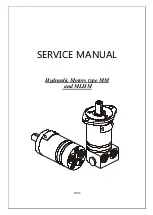
Vehicle
Systems
Testing
and
Adjusting
41
Testing and Adjusting
Troubleshooting
Troubleshooting can be difficult. A list of possible
problems and corrections are on the pages that
follow.
This list of problems and corrections will only give an
indication of where a problem can be and what
repairs are needed. Normally, some more or other
repair work is needed beyond the recommendations
on the list. Remember that a problem is not
necessarily caused only by one part, but by the
relation of one part with the other parts. This list can
not give all possible problems and corrections. The
serviceman must find out the problem and its source,
and then makes the necessary repairs.
Tools Needed
Fittings Group 1
The pressure Gauge Kit or the Tetragauge Group
can be used to make the pressure tests of the
hydraulic system. Before any test is made, visually
inspect the complete hydraulic system for leackage
of oil and for parts that have damage.
WARNING
To prevent personal injury, when testing and
adjusting the hydraulic system, move the
machine to a smooth horizontal location and
lower the mast and carriage to the ground. If the
mast and carriage can not be on the ground,
make sure they are blocked correctly to keep
them from a fall that is not expected. Move away
from machines and personnel that are at work.
There must be only one operator. Keep all other
personnel away from the machine, or where the
operator can see the other personnel.
Before any hydraulic plug, line or component is
removed, make sure all hydraulic pressure in the
system is released.
Visual Checks
A visual inspection of the hydraulic system and its
components is the first step when a diagnosis of a
problem is made. Lower the carriage to the floor and
follow these inspections:
1.
Measure the oil level. Look for air bubbles in the
oil tank.
2.
Remove the filter element and look for particles
removed from the oil by the filter element. A
magnet will separate ferrous particles from non
ferrous particles(piston rings, O-ring, etc).
3.
Check all oil lines and connections for damage or
leaks.
4.
Check all the lift chains and mast carriage welds
for wear or damage.
Performance Tests
The performance tests can be used to find leakage
in the system. They can also be used to find a bad
valve or pump. The speed of rod movement when
the cylinders move can be used to check the
condition of the cylinders and the pump.
Lift, lower, tilt forward and tilt backward the forks
several times.
1.
Watch the cylinders as they are extended and
retracted. Movement must be smooth and regular.
2.
Listen for noise from the pump.
3.
Listen for the sound of the relief valve. It must not
open except when the cylinders are fully
extended or retracted, when the forks are empty.
Hydraulic Oil Temperature (Too Hot)
When the temperature of hydraulic oil gets over
98.8
°
C (210
°
F), polyurethane seals in the system
start to fail. High oil temperature causes seal failure
to become more rapid. There are many reasons why
the temperature of the oil will get this hot.
1.
Hydraulic pump is badly worn.
2.
Heavy hydraulic loads that cause the relief valve
to open.
3.
The setting of the relief valve is too low.
4.
Too many restrictions in the system.
5.
Hydraulic oil level in the tank is too low.
6.
High pressure oil leak in one or more circuits.
7.
Very dirty oil.
8.
Air in the hydraulic oil.
















































